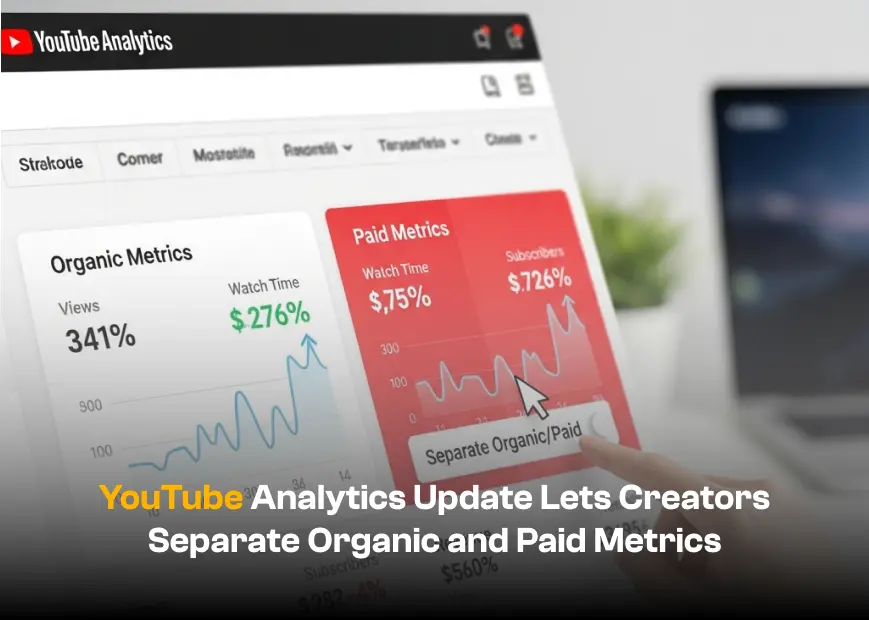YouTube Analytics Update Lets Creators Separate Organic and Paid Metrics


YouTube has rolled out a new feature in YouTube Analytics. With this update, creators can now filter metrics of both organic and paid traffic. The change eliminates the misunderstanding of the impact of paid promotions on channel performance.
Before this update, the views, watch time, and engagement metrics were used to aggregate paid and organic traffic. Producers had a hard time understanding the performance of the organic content that they created. YouTube Analytics can now view organic content separately.
What Has Changed in the YouTube Analytics
YouTube analytics is now available with the option to filter traffic sources on core engagement metrics.
Creators can now filter:
- Views
- Engaged views
- Likes
- Comments
- Shares
- Watch time
Traffic sources can now be divided by all of these metrics. This implies that you would be able to see the results of organic reach only. Also, you can trace the metrics of paid promotional activities such as YouTube Promote ads and brand-sponsored content.
YouTube explained that organic and paid performance are different systems. Organic growth is not impacted negatively by advertising. The algorithmic system of the platform suggests the videos depending on the amount of watch time, viewers and interaction. The paid campaigns are autonomous depending on budget and targeting preferences.
Reason Why Creators Needed this Update
The issue of uniting paid and organic measures was regularly raised by creators. As an instance, an advertised video may target a fresh base of consumers with a different interaction style compared to the standard subscribers. These measures together might result in a retention or click-through rate being worse than the actual organic performance of the content.
Now creators can do:
- Analyse organic content without the interference of paid marketing.
- Know what strategies will bring actual growth.
- Determine whether poor retention is a result of content or ad targeting.
- This assists creators in making improved choices on content and campaigns.
How It Works
In YouTube Analytics, it is possible to filter traffic after the update. You can choose the metric that would be displayed, and then either organic or paid traffic. It is also possible to compare the results of different videos or campaigns.
YouTube clarified that word of mouth is measured by organic performance. It relies on the quality of the recommendation of your video by the algorithm to the audience. Paid performance is determined by ad placement and money, and not algorithmic suggestions.
Such a distinction enables creators to assess every form of growth separately. You will no longer need to guess as to whether the spike in views was as a result of ads or organic reach.
Benefits for Creators
The YouTube analytics upgrade will present a number of benefits:
- Better Performance Illumination: Content creators will have an opportunity to view the actual performance of unpaid content.
- Better Content Choices: Creators can understand the reach of organics to make informed choices of what videos will have an impact on viewers.
- More Precise Reporting: Brands and advertisers will be able to follow the paid campaigns individually.
- Better Growth Strategies: Creators are able to work on strategies that will perform without giving credit to paid advertisements.
- Streamlined Ad Campaigns: You can observe the impact of paid campaigns on new audiences without affecting your organic data.
This proves to be of great use with channels that frequently fire both organic and paid publicity.
Conquering Creator Concerns
Other creators worried that advertisements would decrease their average engagement. YouTube observed that this is because paid ads usually target new viewers who might not be as involved as current followers. This might dilute average retention or click-through rates in combination with organic ones.
These effects can be isolated by the creators using the new filtering. They can view what is performing well in the organic state and what is obtained with paid campaigns. Planning and reporting become very easy because of this transparency.
Conclusion
The new YouTube analytics version is a game-changer for creators. Distinguishing between organic and paid metrics will allow you to notice which content would actually be appreciated by your audience. It also makes sure that the paid video campaigns do not shadow the performance of your free video.
With this functionality, a creator will have the advantage of making more knowledgeable decisions, enhancing their content, or interacting in a better way. This kind of change will give YouTube creators the required visibility in order to grow their channels and be confident.
With or without ads, this update simplifies performance measurement and makes it more precise. It is now easier than ever to understand the distinction between organic and paid traffic.YouTube is still a developing sphere and those who can apply these insights successfully can remain at the top of the competitive world of online video.


